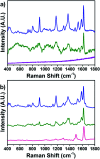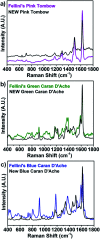Plasmonic colloidal pastes for surface-enhanced Raman spectroscopy (SERS) of historical felt-tip pens
- PMID: 35542010
- PMCID: PMC9078556
- DOI: 10.1039/c7ra13464a
Plasmonic colloidal pastes for surface-enhanced Raman spectroscopy (SERS) of historical felt-tip pens
Abstract
Surface-enhanced Raman spectroscopy (SERS) has been identified as a suitable technique for the analysis of colorants in works of art. Herein, the application of SERS to the identification of dye compositions in historical felt-tip pens is reported, which is of paramount importance for the development of appropriate conservation protocols for historical drawings. In this study, three pens (pink, green, and blue colors) belonging to the film director Federico Fellini were analyzed. SERS measurements were performed directly on the pen lines drawn on a commercial paper by the deposition of Ag colloidal pastes, which allowed fast in situ dye identification without the need for extraction or hydrolysis treatments. Eosin Y was identified as the only dye present in the pink pen ink, whereas erioglaucine was found to be the main dye component in green and blue pen inks. SERS also resulted in highly efficient identification of the individual dyes erioglaucine, crystal violet, and rhodamine present as a mixture in the blue pen ink. The high SERS sensitivity was ascribed to the plasmonic effects and efficient quenching of the fluorescence interference of dyes. A comparison with contemporary pen inks highlighted minor differences in the chemical composition. These results prove that SERS can be used as a fast and sensitive analytical tool for ink analysis that provides invaluable support for the general assessment of the date, provenance, and originality of the historical drawings as well as for the development of preventive conservation protocols.
This journal is © The Royal Society of Chemistry.
Conflict of interest statement
There are no conflicts of interest to declare.
Figures





Similar articles
-
A combined Surface Enhanced Raman Spectroscopy (SERS)/UV-vis approach for the investigation of dye content in commercial felt tip pens inks.Talanta. 2018 May 1;181:448-453. doi: 10.1016/j.talanta.2018.01.049. Epub 2018 Feb 3. Talanta. 2018. PMID: 29426539
-
Raman Spectroscopy and Surface Enhanced Raman Scattering (SERS) for the Analysis of Blue and Black Writing Inks: Identification of Dye Content and Degradation Processes.Front Chem. 2019 Oct 25;7:727. doi: 10.3389/fchem.2019.00727. eCollection 2019. Front Chem. 2019. PMID: 31709241 Free PMC article.
-
Chemical composition of felt-tip pen inks.Anal Bioanal Chem. 2018 Jan;410(3):1079-1094. doi: 10.1007/s00216-017-0687-x. Epub 2017 Nov 2. Anal Bioanal Chem. 2018. PMID: 29098338
-
Surface-Enhanced Raman Spectroscopy Substrates for Food Safety and Quality Analysis.J Agric Food Chem. 2022 May 11;70(18):5463-5476. doi: 10.1021/acs.jafc.2c00089. Epub 2022 Apr 26. J Agric Food Chem. 2022. PMID: 35471937 Review.
-
Plasmonic substrates for biochemical applications of surface-enhanced Raman spectroscopy.Spectrochim Acta A Mol Biomol Spectrosc. 2024 Mar 5;308:123786. doi: 10.1016/j.saa.2023.123786. Epub 2023 Dec 16. Spectrochim Acta A Mol Biomol Spectrosc. 2024. PMID: 38128327 Review.
Cited by
-
Applying Gel-Supported Liquid Extraction to Tutankhamun's Textiles for the Identification of Ancient Colorants: A Case Study.Gels. 2023 Jun 25;9(7):514. doi: 10.3390/gels9070514. Gels. 2023. PMID: 37504394 Free PMC article.
-
New Advances in Dye Analyses: In Situ Gel-Supported Liquid Extraction from Paint Layers and Textiles for SERS and HPLC-MS/MS Identification.Molecules. 2023 Jul 8;28(14):5290. doi: 10.3390/molecules28145290. Molecules. 2023. PMID: 37513166 Free PMC article.
References
-
- Gherandi E. Degano I. Colombini M. P. Mazurek J. Schilling M. Khanjian H. Dyes Pigm. 2015;123:196–403. doi: 10.1016/j.dyepig.2015.07.040. - DOI
-
- Papliaka Z. E. Andrikopoulos K. S. Varella E. A. J. Cult. Herit. 2010;11:381–391. doi: 10.1016/j.culher.2010.02.003. - DOI
-
- Sodo A. Bicchieri M. Guiso M. Ricci M. A. Ricci G. J. Raman Spectrosc. 2012;43:1781–1787. doi: 10.1002/jrs.4070. - DOI
-
- Izzo F. C. Vitale V. Fabbro C. Van Keulen H. Microchem. J. 2016;124:919–928. doi: 10.1016/j.microc.2015.09.008. - DOI
LinkOut - more resources
Full Text Sources
Miscellaneous

